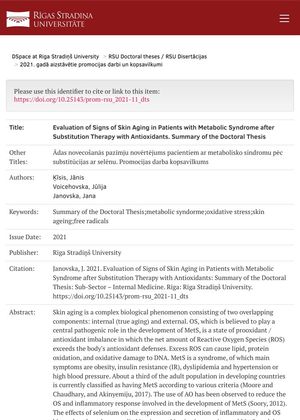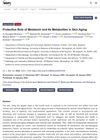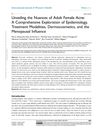Evaluation of Signs of Skin Aging in Patients with Metabolic Syndrome after Substitution Therapy with Antioxidants. Summary of the Doctoral Thesis
September 2021

TLDR Antioxidant therapy, especially with selenium, can improve skin aging in patients with Metabolic Syndrome.
The document discusses a study aimed at examining the signs of skin photoaging and the effectiveness of antioxidant (AO) therapy in patients with Metabolic Syndrome (MetS) in the Latvian population. MetS, characterized by obesity, insulin resistance, dyslipidemia, and hypertension, affects about a third of the adult population in developing countries. Oxidative stress (OS), an imbalance where Reactive Oxygen Species (ROS) exceed the body's antioxidant defenses, is believed to play a significant role in MetS development. Excess ROS can cause lipid, protein oxidation, and oxidative damage to DNA. The study hypothesizes that AO substitution, particularly with selenium, improves skin aging parameters in MetS patients. This is based on previous observations that AO use reduces OS and the inflammatory response involved in MetS development. The study's tasks include evaluating MetS symptoms and skin parameters, identifying and describing skin aging signs, evaluating skin changes after selenium substitution, and assessing the interrelationships between MetS symptoms, OS parameters, and skin changes.

